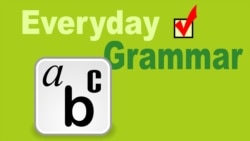Today on Everyday Grammar, we will explore some differences in American English spoken in different regions, or parts of the country.
The United States is a large country, and there are areas where people use different words for the same thing or say the same words differently.
Although school systems across the country teach standard American English, many Americans grow up speaking non-standard American English. These varieties are also called dialects. People may not even realize they are speaking a non-standard form of the language.
Let us look at some vocabulary and pronunciation differences from different regions of the United States.
Vocabulary
One of the main features of different regional varieties of American English is vocabulary. Different words can be used for the same idea or concept, depending on the region of the U.S., such as the Northeast, the South, the Midwest or the West.
Take for example a kind of cloth shoe that is worn for informal times or for sports. What would you call this?
Many Americans in the South, Midwest, and the West Coast call sports shoes “tennis shoes.” It does not matter if they play the sport of tennis. The shoes just might be their everyday shoes. They call them “tennis shoes” anyway. In parts of the Northeast and some parts of southern Florida, they use the word “sneakers.”
Sugary, carbonated drinks have different names depending on where you are from.
In the Midwest, the western part of the state of Pennsylvania, and parts of the Appalachian Mountains, especially in the state of West Virginia, people call the drinks “pop.”
In parts of the Northeast and the West Coast, they are called “soda.” In addition, people in some southern states use one name for all those kinds of sugary drinks. They call it “Coke,” which is short for Coca Cola.
For our final vocabulary word, we have the insect that flies at night in the summertime and lights up. In parts of the Northeast and West coast, the word “firefly” is commonly used. In parts of Appalachia, the Midwest, and the South, “lightning bug” is probably most common. Sometimes people in the U.S. use both words.
Pronunciation
In the U.S., people say some of the same words in different ways, depending on where they grew up.
Take for example a small stream of water that flows into a river. Most Americans say this word as “creek” with a long /ee/ sound, like in the word “beet.”
But in some parts of Appalachia like western Pennsylvania, West Virginia, and the Ohio Valley, you might hear this word with a /i/ sound, as in “creek,” like in the word “tip.”
Our next pronunciation variation is a full merger of two vowels, the / ɒ / as in the vowel sound in “bother” and the / ɔ / vowel as in “saw.”
In most variations of American English, these two vowels are separate and different. You can hear this difference in the words “caught” and “cot.”
In some varieties of American English, especially in the eastern mountains of Appalachia, these two vowels have merged into one, like in the word “cot.” These two separate words, caught and cot, sound the same in that pronunciation.
Our final pronunciation variation is a difference in how many syllables make up the word, “caramel.” Syllables are the parts a word is naturally divided into when pronounced.
“Caramel” (two syllables) or “caramel” (three syllables) is a light brown candy made from butter, sugar, and milk. In much of the Northeast and parts of the South, this word is pronounced with three syllables, /CA-ra-mel/. In parts of the Appalachian Mountains and much of the Midwest, many Americans pronounce this word with two syllables, as in /CAR-mel/.
These two pronunciations can have different meanings depending on the speaker or region. Caramel (two syllables) may mean a mixture of just sugar and water that that turns brown when boiled. Caramel (three syllables) may mean the light brown candy.
Closing thoughts
Today we looked at some differences in vocabulary and pronunciation in regions of the US. There are several varieties of American English including cultural and ethnic varieties, which we have not covered. If you liked learning about these variations in American English, please write to us in the comments. We would love to share more about this subject!
Finally, let us end this report with some homework. Do you know of any variations or dialects in your first language? Or have you heard about other variations in American English? Write to us at [email protected] or in the comments and share what you know about language variation!
I’m Faith Pirlo.
And I’m Jill Robbins.
Faith Pirlo wrote this report for VOA Learning English.
___________________________________________________________________
Words in This Story
region — n. a part of a country or the world that is different or separate from other parts
standard — n. a level of quality, achievement, etc., that is considered acceptable or desirable
varieties — n. numbers of different things
dialects – n. a form of language people speak in a particular part of a country
vocabulary –n. the words that make up a language
pronunciation –n. the way in which a word is normally or correctly said
features – n. usual qualities or important parts of something
concept – n. an idea of what something is or how it works
beet – n. a garden plant with thick leaves and a rounded red root tip – n. a piece of useful advice
merger – n. the combing of two things into one
cot – n. a fold-up bed made of cloth















